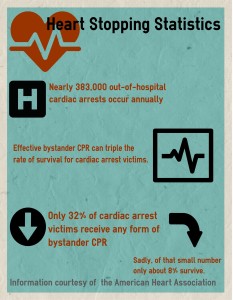Andrew Franklin
Reporter
Earlier this semester, tragedy struck very close to home for students at Crowder College. International student Mutombo Hughes Kazadi, from the Democratic Republic of Congo, passed away of unspecified cardiac issues. Kazadi was only 22 years old, which isn’t that much older than the average college student in America, and there were no signs of foul play related to the cardiac issues.
While tragic, we should take time to learn from this situation, and realize that cardiac arrest can happen to anyone, regardless of age, physical fitness, and other relevant factors. According to the American Heart Association, nearly 383,000 out of hospital cardiac arrests occur annually, and many victims appear to be perfectly healthy at the time of cardiac arrest. Statistics show that effective bystander cardiopulmonary resuscitation, or CPR, can double or triple the survival rate of a victim of cardiac arrest. Statistics also show that a dismal 32% actually receive any bystander CPR, and that only about 8% of cardiac arrest victims outside of the hospital survive.
These are pretty disheartening statistics, to say the least. So what can we do about them?
Well, the first option is to take a CPR class. American Heart Association, Red Cross, and often local first responder departments can offer CPR training year-round, making any day the perfect day to get qualified. The class, usually no more than six hours, prepares attendees to perform CPR effectively, as well as deal with other common first aid situations which people are typically unprepared for, and costs anywhere from $100-$200.
Of course, many college students may find that with a busy lifestyle, there’s little incentive or desire to seek out an instructor to toss money at for a class in CPR and general first aid. Instead, colleges and universities should offer CPR training as an alternative to a science course, or even make CPR a required credit to graduate, aside from other graduation requirements. This would allow students to graduate not only proficient in their specific major, but having life skills that transcend education, profession, and all else.
Instead of being a full semester, this class could be offered for the first eight weeks, and for the second eight weeks. Since a six hour class costs about the same as a college class in general, the cost difference would be minimal, and could possibly even be the cheaper alternative. In eight weeks, students could not only get very familiar with performing CPR, but could also extensively cover first aid, allowing a broader and more thorough coverage of potentially life-saving techniques than those acquired in a single class with the AHA or Red Cross.
Furthermore, having CPR training, aside from being a beneficial life skill, is excellent on a resume, allowing students to graduate with a degree and that extra bullet point that may land them a job over other applicants. Seeing as cardiac arrest can happen anywhere, an employer can rest a little easier knowing they have someone certified in not only CPR, but in a variety of first aid techniques, making this a legitimate selling point on any resume.
Ultimately, it is up to each individual to decide if they will contribute to raising survival rates of cardiac arrest victims, or letting that survival rate stay at the already unacceptably low percentage that it currently sits at. If you want to be part of the change, then let’s get this in the course catalogue, and let’s get this put up as a requirement to graduate from this institution, as well as all other institutions that wish to produce truly well-rounded, beneficial members of society.


Leave a Reply